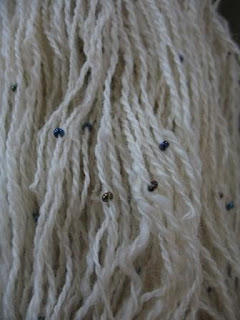So, the only way I could think of making a beaded yarn was to string beads on one of the plies of yarn, then stagger the beads as I plied. I spun up some coopworth fiber as thin as I could, then took a bag of black irridescent seed beads and using a wire beading needle, I strung on a good number of beads onto it. Well, I quickly found out that it was going to be a very slow and tedious process. I managed to get a couple of small skeins done, but soon lost interest and put the rest of it into a bag and stowed it away.
That was 10 years ago. This year, I began cleaning my craft room and found the bag with the seed beads and the ball of yarn still waiting for me to finish it. It took some effort, but I managed to make myself sit back down at my wheel and start working on it again.

It was still tedious, but this time I knew an end was in sight. Just one more ball of yarn to go and I would be finished!

And whalla! It's done! Heck, I'm not even sure what I was making this yarn for anymore! I think I just wanted to see if I could do it. And I did. And I know I'll never do it again! At least not that way. I'm really surprised that I never had the yarn break as I was pulling those beads along as I plied.

So, this was how not to spin a beaded yarn. The way you are supposed to do it, is string the beads onto a thread and ply it along with the spun yarn. While cleaning my craft room, I also found alot of beads that need a use. I plan to do some more experimenting in the new year, and you can be sure, I'll be doing my homework first this time!













.JPG)

